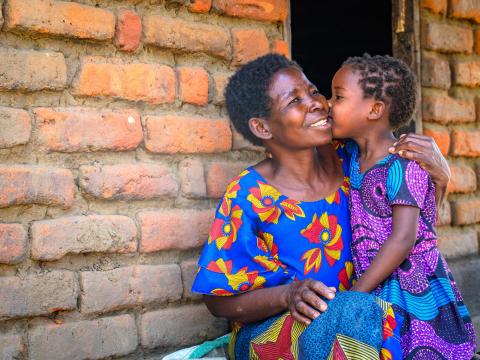Placing Children at the Centre of Sustainable Development Goals – Zero Hunger, Good Health and Gender Equality


By Joining Forces, East and Southern Africa Region - ChildFund Alliance, Plan International, Save the Children International, SOS Children’s Villages International, Terre des Hommes International Federation, and World Vision International
11th Session of the Africa Regional Forum on Sustainable Development (ARFSD-11)
Placing Children at the Centre of Sustainable Development Goals – Zero Hunger, Good Health and Gender Equality
7th April 2025- As African governments convene at the 11th Session of the African Regional Forum on Sustainable Development (ARFSD0-11) hosted by the Government of Uganda in partnership with the United Nations Economic Commission for Africa and the Africa Union from 9th April to 11th April 2025, the Joining Forces Alliance in Africa, a coalition of six leading child-focused organizations, is urging accelerated action by African Governments to meet the Sustainable Development Goals (SDGs) with children at the forefront.
With the deadline for achieving the Sustainable Development Goals under Agenda 2030 swiftly approaching, the alliance is calling on African governments to prioritize SDG 2 (Zero Hunger), SDG 3 (Good Health and Wellbeing), SDG 5 (Gender Equality) and SDG 8 (Decent Work and Economic Growth) to ensure no child is left behind. The theme of ARFSD-11, Driving Job creation and economic growth through sustainable inclusive, science and evidence-based solutions for the 2030 agenda and agenda 2063, underscores the urgent need for transformative policies that benefit future generations.
As African Governments review progress, challenges and opportunities on the implementation of Agenda 2030, children’s views and recommendations need to be incorporated in the outcome document and influence policy, strategies and programmes. The alliance emphasizes that meaningful engagement with children and youth is essential for creating inclusive and impactful solutions. We therefore commend the Pre-Event that will include children and youth.
According to the World Bank’s Investment Framework for Nutrition, 20241, every US$1 invested in addressing undernutrition yields a US$23 return due to improved health and productivity. However, currently global nutrition investment is only less than 1% of all aid.-. Government investments need to prioritise children’s nutrition concurrently with health, education, and water and sanitation. As stated in the Summit for the Future, Outcome Document, in which the Joining Forces played a key role in shaping, with the Pact of the Future to include children.
Nutrition is a key determinant of healthier populations, and malnutrition in all its forms is a key risk factor, with serious impact on morbidity and human capital across the life-course3. Healthy diets and nutrition interventions are paramount to achieve the SDGs.
The pact further includes commitments to protect children from armed conflict, recognize them as agents of positive change, and invest in their development through health, education, and social protection.
Call to Action and Recommendations
As we approach the midpoint of the SDG timeline, now is the time for bold leadership to achieve SDGs 2, 3, 5 and 8. The Joining Forces in Africa calls for a multi-sectoral approach to sustainable development, that recognizes the interconnection between health, gender equality, and economic growth.
To ensure no child is left behind, the alliance calls on African National governments to addressing the following:
SDG 3 – Good Health and Wellbeing
•Reduce reliance on external donors and domestically invest in maternal and childhealth services, including skilled birth attendants and emergency obstetric care.
•Strengthen health systems by investing in training and deploying communityhealth workers (CHWs) to provide primary health care, and promote maternaland child health at the community level.
SDG 5 – Gender Equality
•Strengthen social protection systems to protect women and girls from violence,including child marriage and Female Genital Mutilation (FGM).
•Align national laws with international standards to set 18 as the legal age ofmarriage and enforce these laws effectively.
•Design, implement and scale up national awareness-raising and socialbe havioural change initiatives and partner with faith and community leaders to
change harmful attitudes, behaviours and practices that contribute to child marriage and FGM.
SDG 2 – Zero Hunger
•Strengthen health systems and the community health workforce, so they canincrease the effective coverage of Essential Nutrition Actions delivery, ensuringthat every child, has access to the care they need.
•Develop policies to ensure access to safe and nutritious food for all,particularly vulnerable populations, while supporting small-scale farmers.
•Set clear nutrition financing targets and strengthen health systems to deliveressential nutrition services to every child.
SDG 8 - Decent Work and Economic Growth
•Expand financial inclusion for women through microfinance, enabling familiesto invest in their children’s education and health.
•Create decent jobs and reduce poverty through skills training and support formarginalized communities.
About Joining Forces Alliance:
The Joining Forces Alliance is a collaboration of six leading child-focused organizations—ChildFund Alliance, Plan International, Save the Children International, SOS Children’s Villages International, Terre des Hommes International Federation, and World Vision International —working together to amplify the voices of children and hold governments accountable to their commitments. Through partnerships with governments, UN agencies, and civil society organizations, the alliance strives to create a world where every child thrives.
##The End##